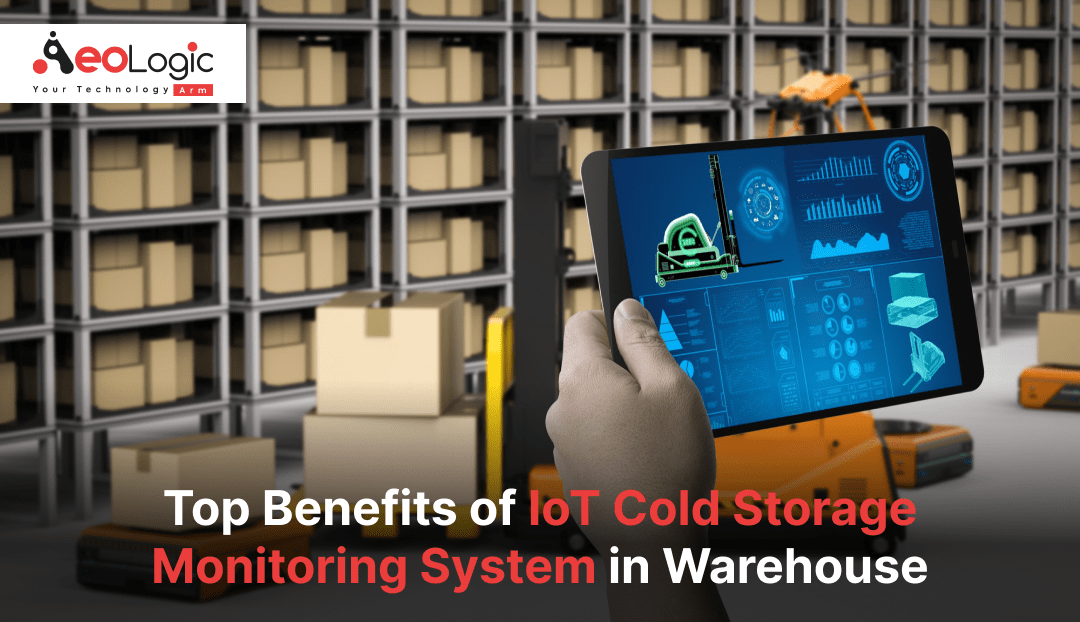Now the use of technology in logistics and supply chain is increasing at a high pace. We all know that warehouse management is very important these days, especially for businesses dealing with perishable items like food, pharmaceuticals, and certain chemicals. One of the most critical aspects of such warehouses is cold storage, where temperature, humidity, and other environmental factors must be precisely controlled. Here comes the Internet of Things (IoT)—a technology that’s upgrading cold storage monitoring. By integrating IoT solutions into warehouse management, businesses are experiencing transformative changes in efficiency, safety, and cost-effectiveness.
Here we’ll explore the top benefits of IoT-based cold storage monitoring systems in warehouses, revealing how this technology provides a competitive advantage, reduces risks, and enhances operational capabilities.
Let’s look at these one by one:
What is an IoT Cold Storage Monitoring System in Warehouses?
An IoT Cold Storage Monitoring System in warehouses uses connected sensors to track and manage temperature and humidity in real-time. This system is vital for industries like food and pharmaceuticals, where temperature-sensitive products need precise conditions to remain safe and effective.
With IoT technology, the system continuously gathers data, sending alerts if temperatures exceed safe levels, allowing quick action to prevent spoilage. By reducing waste, improving energy efficiency, and supporting compliance with quality standards, IoT cold storage monitoring ensures that warehouses maintain optimal conditions for sensitive goods.
1. Provides You With Real-Time Monitoring and Alerts
IoT sensors provide real-time data on temperature, humidity, and other environmental conditions within a cold storage facility. Traditional monitoring systems often depend on manual checks, which can be prone to delays and human error. However, with IoT, data is continuously collected and analyzed, allowing for immediate insight into the status of storage conditions.
- You Get Immediate Alerts: IoT systems send instant alerts if temperatures fluctuate outside set parameters. For example, if the cooling unit malfunctions, a warehouse manager receives a notification via SMS, email, or through an app.
- Early Issue Detection: With constant data streaming in, even minor irregularities can be flagged before they escalate into bigger issues, reducing the likelihood of large-scale product spoilage.
- Round-the-Clock Surveillance: IoT-enabled cold storage systems run 24/7, providing peace of mind and reducing the need for night-shift staff just for temperature monitoring.
2. These Monitoring Systems Enhance Product Quality and Safety
One of the primary concerns in cold storage is ensuring product quality and safety, particularly for food and pharmaceutical items. Temperature deviations can spoil goods or reduce their efficacy, leading to product wastage and, more seriously, potential health risks.
- Helps in Maintaining Consistent Temperature: IoT ensures that products are stored within their required conditions, maintaining quality and safety.
- Use of IoT Reduces Risk of Contamination: By consistently maintaining the proper environmental conditions, IoT systems reduce the risk of contamination or spoilage, safeguarding consumer health.
Also Read: The Role of IoT Solutions in the Future of Manufacturing Industry
3. IoT Cold Storage Monitoring System Helps in Cost Savings
Cold storage facilities are known for their high energy consumption. However, by using IoT-based monitoring systems, warehouse operators can reduce operational costs significantly.
- Energy Efficiency: IoT sensors optimize energy consumption by adjusting temperatures only when necessary, ensuring that power isn’t wasted on overcooling. This can lead to significant savings on electricity bills.
- It Reduces Product Loss: By preventing spoilage, businesses can avoid the costly process of discarding unusable goods and reordering stock. This is particularly beneficial for businesses dealing with high-value products.
- Helps in Maintenance Cost Reduction: IoT systems also monitor equipment health, allowing for predictive maintenance. Identifying equipment that may require repairs reduces the risk of costly breakdowns and extends the lifespan of machinery.
4. Helps in Predictive Maintenance for Refrigeration Equipment
One of the standout features of IoT in cold storage is the ability to predict when equipment will need maintenance, thus preventing sudden breakdowns and minimizing downtime. IoT devices collect data on various performance metrics of cooling units and compressors, helping detect anomalies before they lead to full-scale malfunctions. IoT systems can be programmed to alert staff when it’s time for routine maintenance, reducing the risk of unexpected breakdowns. Also By anticipating and fixing issues before they lead to larger failures, IoT-enabled maintenance significantly reduces the downtime and costs associated with emergency repairs.
Also Read: The Role of IoT in Enhancing Asset Management
5. IoT Cold Storage Monitoring System Helps in Data-Driven Decision Making
IoT cold storage systems provide warehouses with a wealth of data. When analyzed, this data can offer insights into operational patterns and potential areas for improvement.
- With continuous data collection, managers can analyze trends, like peak times for cooling unit usage, allowing for more efficient resource allocation.
- By comparing historical data, warehouses can evaluate the performance of their cold storage units over time and make informed decisions regarding upgrades or replacements.
- IoT data can help businesses forecast seasonal demand and prepare storage capacities accordingly, helping minimize waste and optimize inventory levels.
6. It Improves Compliance and Record-Keeping
Compliance with industry standards is critical for cold storage warehouses, particularly in sectors like pharmaceuticals and food. IoT-based cold storage monitoring helps in maintaining thorough records that are often required during audits.
- Automated Record-Keeping: IoT systems automatically log environmental data, eliminating the need for manual record-keeping, which can be time-consuming and prone to error.
- Audit-Ready Documentation: With digital records readily available, warehouses can quickly provide detailed reports during regulatory audits.

7. These Systems Enhance Inventory Management
Inventory management is essential in cold storage, where delays in processing or locating goods can impact the product’s lifespan and quality. IoT cold storage monitoring offers a way to optimize inventory handling and minimize wastage.
- Improves Product Rotation: IoT systems can track the age of items in storage, ensuring that older products are used first, following a FIFO (first-in, first-out) approach to minimize spoilage.
- Smart Shelving and Space Utilization: IoT sensors and RFID tags can locate products precisely, making it easier to maximize storage space and reduce search time.
- Inventory Alerts: Some IoT systems can alert when inventory levels fall below a certain threshold, ensuring timely reordering of essential items without overstocking.
Also Read: IoT-Based Safety Monitoring System For Construction Workers
8. IoT Helps in Better Environmental Sustainability
Reducing energy consumption in cold storage facilities is a step toward achieving environmental sustainability. IoT-based cold storage monitoring systems support green initiatives by optimizing resource use and reducing carbon footprints.
- Efficient Resource Use: IoT sensors help maintain efficient energy use by ensuring cooling only when necessary, preventing wastage.
- Lower Carbon Emissions: By reducing energy usage, IoT technology helps companies decrease their carbon footprint, contributing to a more sustainable operation.
- Sustainable Practices as a Selling Point: Customers and clients increasingly prefer businesses with sustainable practices. IoT cold storage systems can give warehouses a marketing advantage by showcasing commitment to environmentally friendly operations.
9. It Enhances Security and Access Control
IoT cold storage monitoring systems can also improve the security of cold storage areas, safeguarding products from unauthorized access and tampering.
- Access Control Systems: IoT-enabled access control can limit entry to the cold storage area, ensuring only authorized personnel can enter.
- Automated Security Alerts: In case of unauthorized access, the system can alert security personnel or management, enabling quick action.
- Monitoring of Door Open Times: IoT systems can track how long cold storage doors are open, which can be critical in maintaining temperature levels and ensuring security.
10. Use of IoT Cold Storage Monitoring System Provides Better Customer Satisfaction
Ultimately, the primary goal of any cold storage facility is to maintain product integrity, and IoT Cold Storage Monitoring Systems make this process much more efficient and reliable. IoT monitoring helps ensure products are stored in optimal conditions, increasing the chances that they reach end-users in excellent quality. IoT-based systems allow businesses to provide clients with verified data on storage conditions, helping build trust and ensuring transparency. Efficient cold storage management minimizes delays in dispatching perishable goods, ensuring timely deliveries and customer satisfaction.
Related Blog: How IoT Solutions Drive Innovation Across Industries
Final Words
The integration of IoT in cold storage monitoring systems represents a leap forward in warehouse management. IoT brings real-time monitoring, predictive maintenance, and data-driven decision-making to the forefront, significantly reducing the risks associated with cold storage. From enhancing product quality and safety to promoting environmental sustainability and energy efficiency, IoT-enabled cold storage monitoring offers warehouses a comprehensive solution that caters to modern demands and market standards.
In an industry where the smallest fluctuations in temperature can lead to significant product losses, IoT provides a layer of security, reliability, and efficiency that is increasingly indispensable. As technology advances, the capabilities of IoT cold storage monitoring systems will only grow, further supporting warehouses in optimizing operations, reducing costs, and achieving their business goals.
Connect with Aeologic Technologies to explore how we can help bring the power of IoT to your cold storage management and protect your products seamlessly.
By embracing IoT in cold storage, warehouses can not only protect their inventory but also enhance their service offerings, ensuring satisfied customers and long-term success.






